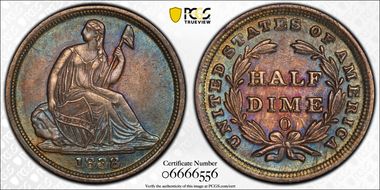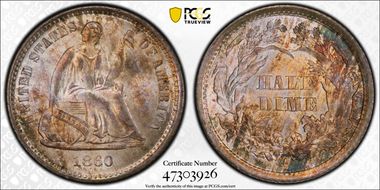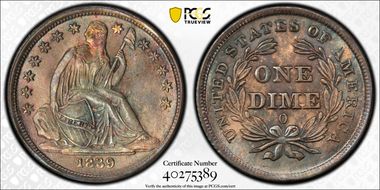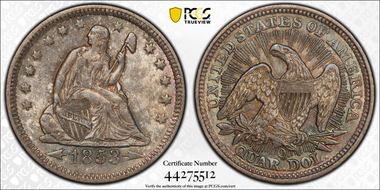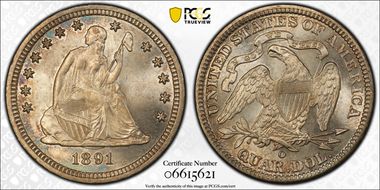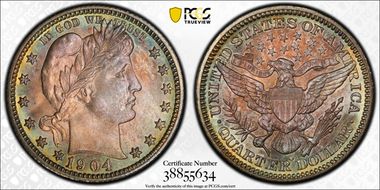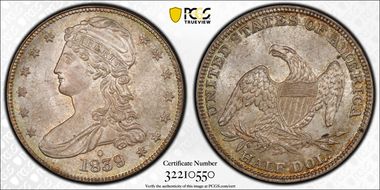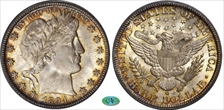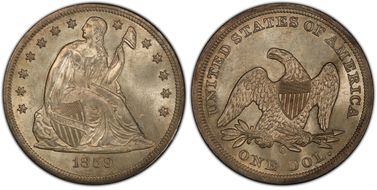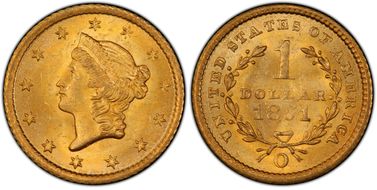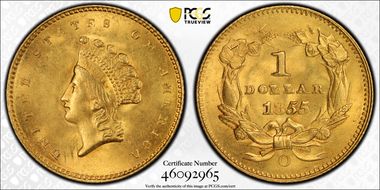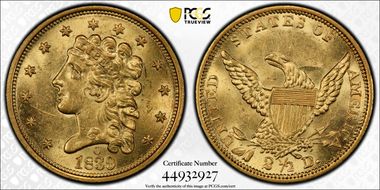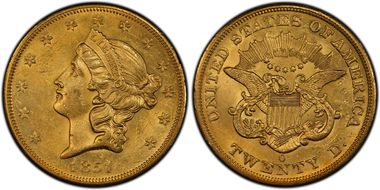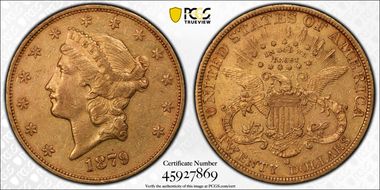400 Esplanade 的钱币相册
V-3. There are die cracks on the reverse thru A of STATES and both A's of AMERICA. CAC.
V-1. high date, die crack thru stars 1-5. low 7 in date. vertical line at rock base on left. With a mintage of 1.38 million, the 1857-o is a relatively common date. Apparently a number were set aside in mint condition as Al Blythe's 1992 reference on the series only rates the '57-O as R.3 in Unc. From the #1 ranked, retired Sounder Type Set at NGC. CAC
V-3. The arrows are high and nearly touch the base. The date is also high and irregular with the 3 being lower. Die cracks are seen on the reverse above STATES. The mintmark is nearer the right bow. Ex: Gardner. CAC.
Fortin 104a. Ex: Simpson. Boldly repunched MM north and west, horizontal die crack across (U)NITED (DIME) AMERI(C)A
Fortin 103: medium level date, open 5, with die chips seen about star 5, medium o. A-2, G101. Ex. Superior Worrell Collection Lot 374 Sept 1993. CAC.
Fortin 106a. O/O. The 8 & 9 are repunched at the bottom. The attribution is clinched as the remnant of an o is visible within the medium o. Heavy die clashing is seen at the right of lady liberty. This is the late die state as cracks are beginning to form on either side of the mint mark. CAC.
Briggs 2B. Ex: Pittman. The Briggs 1A coins show a mintmark far to the left. 1A coins were also found in the famous New Orleans Hoard excavation of 1982 on Canal Street in the French Quarter.
Briggs 1A: Fortunately, none of the imaging of this coin revealed its true beauty. This coin is highly reflective and sharply struck. It is no surprise this coin is in a 64 holder-no one would question a + designation here.
GR-1. RPM. This is the most common variety accounting for 90%+ of the 110k produced. Extensive die craking on both sides is also a diagnostic clue.
Ex: J.M. Clapp, John H. Clapp, Louis Eliasberg, Sr., Larry Miller. Not long after publication of Augustus Heaton's Mint Marks in 1893, John M Clapp began a yearly purchase of mint state coins by writing to the various mints. This was one of the first he purchased directly from the New Orleans Mint though late in the year, November 1894. OGH. CAC
This is one of three Morgan Silver Dollar issues, along with 03-o and 04-o, that had been considered rare prior to release of the Treasury Hoard of the 1960s. Of the 4.44 million 98-o dollars, a substantial percentage was set aside and eventually distributed through the Federal Reserve System in late 1962. Few, however, show the well preserved surfaces seen on this piece. This coin is all white and only has light grazes that show up amazing well on these high resolution scans.
Winter V-2. Ex: Harry Bass, Jr via John Rowe and Mike Brownlee privately 2/24/1967 and impounded in the ANA Money Museum in Colorado Springs until its current release. CAC
Winter V-2: Low date, close fraction. This is the finest known of the close fraction group. The 64, 4+, and 5 are all wide fraction. This is a late die state with shattering.
Winter V-1. Ex: Bass. The one is buried in the dentils and is doubled at its base (Obv1). The Mint Mark is penetrated by arrow feathers and is centered over the fraction bar (RevA). The provenance is not on the holder but matches the Bass II 407 coin, formerly PCGS MS63 at the time of sale in October 1999. There is a copper spot on the reverse at the 2. Thank you Stephen Davidson for locating this coin.
Winter V-2. The more common variety struck from lapped dies. The 1854-o is the first year of issue and the only $3 coin produced at the New Orleans branch mint. With a total mintage of 24,000, most of the coins were presumed to be released into circulation or melted. Only 2 mint state examples are currently slabbed by PCGS (an MS61 and an MS62). Though around 1000 are preserved in PCGS and NGC slabs, the popularity among us collectors make this a difficult date to locate in any grade.
Winter V-2, This is die state II according to Doug Winter's new book. There is a light die crack from star 12 to rim and light peripheral cracking on the reverse. From the New England collection.
Winter V-1. The mintmark is positioned left of the crotch near the fletchling and claw.
Winter V-1. The mintmark is positioned left of the crotch near the fletchling and claw.
Ex: Clapp/Eliasberg. J.M. Clapp purchased this eagle directly from the mint at 400 Esplanade Avenue in New Orleans in 1903 and it was passed on to his son after his death in 1906. It was then sold to Louis Eliasberg after J.H. Clapp died in 1942. The coin was sold at auction in the Eliasberg sale of 1982. It had reportedly not changed hands since the Eliasberg sale...until now. OGH. CAC





















